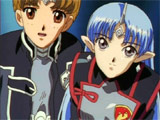

Quick Links:
Banner of the Stars, Volume 3: Only the Beginning...
Wrapping up the Banner of the Stars story, the third volume is filled to the brim with action, suspense, and drama, for one heck of a finish. Looking at both this series, and the overall Crest story, the elaborate structure and deeply personal dialogue continue to impress and manage to build off of its solid foundation. The story remains so engaging that the viewer might experience emotional growth along with the amazing couple: Jinto and Lafiel. To top it off, Bandai's quality transfer and interesting extra material serve to enrichen what is already a great waste of time.
The final volume of Banner begins right where the previous left off, with the massive United Mankind fleet approaching the stronghold formed by the fleet containing the Basroil. The battle between the two has begun, and the enemy deploys the new kind of mine that caused problems for the Basroil and Segroil in the previous volume. The attack ships have difficulty with the mines, so a different type of ship (the guard ships) is sent in to counter the mine attack - and deploy some mines of their own.
The show frequently refers to the barbaric tendencies of the United Mankind, who use technology instead of wit to fight, and have developed a superiority complex by writing off the Abh as not human. It is an interesting angle to take, because the powerful Abh race are depicted as almost victims on the individual level. Fighting to preserve their way of life seems to be the only choice, by this perspective.
After the guard ships begin to make some headway, the enemy sends in attack ships, which the squadron Lafiel belongs to must counter. The show makes a reference to a game called "jousting" that Lafiel was good at as a child, during this battle. Her confidence takes a hit though, when the enemy ships decide to focus their attack on her, causing heavy damages. They end up having to abandon the Basroil, but meanwhile the main force makes it in time to assist the ailed fleet. The show is wrapped up in the final episode, which consists of a lot of dialogue between Jinto and Lafiel, accompanied by dialogue between the admiral Dusanyu (commander-in-chief of the operation Phantom Flame) and his first officer Kenesh. The admiral seems to have a great interest in Jinto and Lafiel, probably because Lafiel is a member of the same Abriel family that he is, and because he was in charge of forcing the surrender of Jinto's planet at the beginning of the story.
The manner in which the story details are delivered is probably the largest reason why the story remains so interesting. One of the best examples is: when Crest of the Stars ended, Lafiel said something to Jinto, but the audience doesn't hear it. What she said is revealed later, in the final volume of Banner of the Stars. I couldn't help but feel like a grounded child when the information was initially witheld, and how great it felt to finally hear it. Banner has its own episode where Lafiel again says something we don't hear, but luckily viewers don't have to wait too long for the resolution of that scene, as it is played out after the credits roll on the last episode. The mastery displayed here in storytelling affords an almost guilty pleasure to the viewer, the likes of which are rarely seen in any form of entertainment. Going back to the previous paragraph, the dialogues between key characters remain equally stimulating, and the gap between human and pure Abh on the Abh side of the fence seems to lessen with each episode, or perhaps it's us getting to know the Abh better instead.
The transfer by Bandai was same-old, same-old, with virtually no change in quality from the last volume. The cover art consisted of Jinto and Lafiel embracing each other, over a backdrop of the same. The cover was reversible, sporting a picture of Kenesh and Dasanyu on the back. The disc extras were also similar to the previous Banner volumes, containing production artwork and another installment of the "Newsletter of the Stars." In this newsletter, Morioka-san talked about the nature of the space battles (more specifically close-combat), and the unfortunate passing of Mr. Kaneto Shiozawa, whose voice graced many shows such as Gundam, Vampire Miyu (OVA), and Nadia, and who played the admiral Dusanyu in Crest and Banner.
As Banner of the Stars came to a close, I found I had great respect for this installment of the Crest saga, and a greater love for the story as a whole. The show never fails to impress at every turn, and has yet to lose even a bit of focus. From action that rivals the best Gundam episodes, to the kind of attention to emotions and personalities rarely seen in the space opera genre, Banner of the Stars (as well as its predecessor) are hereby declared required viewing.
Video Quality: A+ Audio Quality: A Presentation: A+ Content: A+ Overall: A+



